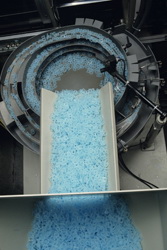Metal-mediated polymerisation for smart materials
The advent of controlled radical polymerisation has led to the development of complex polymer architectures that were once impossible to produce. VAc is a very high-profile monomer or building block due to its application in coatings, textiles and pharmaceutical industries. A disadvantage attached to VAc is that the monomer can only undergo radical polymerisation and is nucleophilic. Complete success in gaining a wide variety of polymer materials has so far been hindered by the resulting inability to control the radical polymerisation process. The 'Toward new polymeric materials by metal-mediated controlled radical polymerization' (Metmed-CRP) project aimed to overcome this limitation. By tuning the strength of metal-carbon bonds in organometallic complexes, they aimed to modulate and control the organometallic radical polymerisation (OMRP) process. To achieve this, metals that do not form very strong metal-carbon bonds are required and iron (Fe) (II) and copper (Cu) (I) therefore fit the bill. Fe-based catalysts seem particularly attractive due to their low cost and toxicity as well as their use in other polymerisation processes. Using Fe in the system, VAc polymerisation is controlled, albeit weakly; additional control was achieved by the addition of phosphines as they slowed down the process. One further problem was higher molecular weights compared to the theoretical proportion. However, results showed relatively low polydispersity (range of size). Use of dimethylphenylphosphine in particular gave the smallest differential between the observed and calculated polydispersity index (PDI). Metmed-CRP scientists have also isolated a metal-capped short oligomer for future use. The team characterised the fragment using nuclear magnetic resonance (NMR) spectroscopy, electron paramagnetic resonance (EPR) and chemical derivatisation and they proved reversible radical release from the oligomer. During the OMRP process, there has to be reversible release of the PVAc chains from the acetylacetonate (acac) 2Fe-PVAc species. Being able to manipulate molecular weights and structures of derived polymers will help to realise the full industrial potential of VAc.







